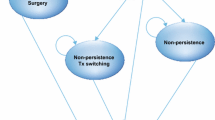Abstract
Purpose
Evidence suggests antimuscarinic drugs for the overactive-bladder syndrome only confer modest improvements in quality of life. We wanted to describe the persistence of therapy, including an extended analysis beyond the 1-year follow-up employed in other studies.
Methods
All prescriptions for drugs in ATC category G04BD were retrieved for the period 1999–2006 from a regional database with complete capture of all reimbursed prescriptions. Kaplan-Meyer curves were generated for duration of treatment for each substance and analyzed for determinants of termination.
Results
With the exception of trospium chloride, all drugs had continuation rates of less than 50% at 6 months, less than 25% at 1 year, and less than 10% at 2 years and longer. Trospium chloride, however, exhibited continuation rates of 46% at 6 months, 36% at 1 year, 22% at 2 years, and 16% at 3 years.
Conclusions
In a setting of socialized medicine, we found higher continuation rates than previously published. Interestingly, we found that one of the older drugs on the market, trospium chloride, had a strikingly longer retention rate than other drugs.

Similar content being viewed by others
References
Abrams P, Cardozo L, Fall M, Griffiths D, Rosier P, Ulmsten U, van Kerrebroeck P, Victor A, Wein A (2002) The standardisation of terminology in lower urinary tract function: report from the Standardisation Sub-committee of the International Continence Society. Neurourol Urodyn 21:167–178
Milsom I, Abrams P, Cardozo L, Roberts RG, Thuroff J, Wein AJ (2001) How widespread are the symptoms of an overactive bladder and how are they managed? A population-based prevalence study. BJU Int 87:760–766 (Erratum in: BJU Int 2001; 88:807)
Finney SM, Andersson KE, Gillespie JI, Stewart LH (2006) Antimuscarinic drugs in detrusor overactivity and the overactive bladder syndrome: motor or sensory actions. BJU Int 98:503–507
Abrams P, Andersson KE, Buccafusco JJ, Chapple C, de Groat WC, Fryer AD, Kay G, Laties A, Nathanson NM, Pasricha PJ, Wein AJ (2006) Muscarinic receptors: their distribution and function in body systems, and the implications for treating overactive bladder. Br J Pharmacol 148:565–578
Nabi G, Cody JD, Ellis G, Herbison P, Hay-Smith J (2006) Anticholinergic drugs versus placebo for overactive bladder syndrome in adults. Cochrane Database Syst Rev 4:CD003781
Halaska M, Ralph G, Wiedemann A, Primus G, Ballering-Bruhl B, Hofner K, Jonas U (2003) Controlled, double-blind, multicentre clinical trial to investigate long-term tolerability and efficacy of trospium chloride in patients with detrusor instability. World J Urol 20:392–399
Haab F, Cardozo L, Chapple C, Ridder AM (2005) Long-term open-label solifenacin treatment associated with persistence with therapy in patients with overactive bladder syndrome. Eur Urol 47:376–384
Kreder K, Mayne C, Jonas U (2002) Long-term safety, tolerability and efficacy of extended-release tolterodine in the treatment of overactive bladder. Eur Urol 41:588–595
Haab F, Corcos J, Siami P, Glavind K, Dwyer P, Steel M, Kawakami F, Lheritier K, Steers WD (2006) Long-term treatment with darifenacin for overactive bladder: results of a 2-year, open-label extension study. BJU Int 98:1025–1032
Yu YF, Nichol MB, Yu AP, Ahn J (2005) Persistence and adherence of medications for chronic overactive bladder/urinary incontinence in the California Medicaid program. Value Health 8:495–505
Shaya FT, Blume S, Gu A, Zyczynski T, Jumadilova Z (2005) Persistence with overactive bladder pharmacotherapy in a Medicaid population. Am J Managed Care 11:S121–S129
Chui MA (2004) Patient persistence with medication for overactive bladder. Value Health 7:366
Zhou Z, Barr C, Torigoe Y, Williamson T (2001) Persistence of therapy with drugs for overactive bladder. Value Health 4:161
Kelleher CJ, Cardozo LD, Khullar V, Salvatore S (1997) A medium-term analysis of the subjective efficacy of treatment for women with detrusor instability and low bladder compliance. Br J Obstet Gynaecol 104:988–993
Saks EK, Northington G, Gopal M, Arya L (2006) Adherence to anti-cholinergic medications in women with urge incontinence. Int Urogyn J 7:5398
Gaist D, Sørensen HT, Hallas J (1997) The Danish prescription registers. Dan Med Bull 44:445–448
Hallas J, Stovring H (2006) Templates for analysis of individual-level prescription data. Basic Clin Pharmacol Toxicol 98:260–265
Hallas J, Gaist D, Bjerrum L (1997) The waiting-time distribution for prescription drugs. Epidemiology 8:666–670
Cox DR (1972) Regression models and life tables. J R Stat Soc B 34:187–220
Bourgault C, Sénécal M, Brisson M, Marentette MA, Grégoire J-P (2005) Persistence and discontinuation patterns of antihypertensive therapy among newly treated patients: a population-based study. J Human Hypertens 19:607–613
Pesce F, Rubilotta E, D’Amico A, Siracusano S, Righetti R, Celia A, Tiberio A, Artibani W (2003) Long-term anticholinergic therapy: duration and causes of discontinuation. Abstract 304 [poster]. International Continence Society 2003, 25–27 August 2003, Paris, France
Brubaker L, Nichol M, Fanning K, Becker R, Jumadilova Z, Benner J (2006) Patient-reported reasons for discontinuing overactive bladder (OAB) medications. Neurourol Urodyn 25:614
Chapple CR, Martinez-Garcia R, Selvaggi L, Toozs-Hobson P, Warnack W, Drogendijk T, Wright DM, Bolodeoku J (2005) A comparison of the efficacy and tolerability of solifenacin succinate and extended release tolterodine at treating overactive bladder syndrome: results of the STAR trial. Eur Urol 48:464–470
Boccuzzi SJ, Le TK, Wogen J, Williamson T (2002) Utilization patterns associated with tolterodine immediate release versus oxybutinin in the management of urinary incontinence (UI). Value Health 5:274
Author information
Authors and Affiliations
Corresponding author
Rights and permissions
About this article
Cite this article
Brostrøm, S., Hallas, J. Persistence of antimuscarinic drug use. Eur J Clin Pharmacol 65, 309–314 (2009). https://doi.org/10.1007/s00228-008-0600-9
Received:
Accepted:
Published:
Issue Date:
DOI: https://doi.org/10.1007/s00228-008-0600-9




